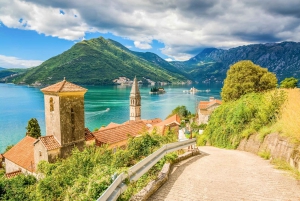Places of interest
The Old Town of Budva is the trademark of Budva with a unique architectural composition. It was built on an island that was connected to the mainland by a sandy coating and thus grew into a peninsula. Historical sources indicate that Budva is one of the oldest urban centres on the Adriatic, over 2,500 years old. A recognisable attraction of the Old Town is the high wall, dating from the Middle Ages when Budva was under Venetian rule. In the earthquake of 1667, Budva was demolished and on the foundation of the old walls, the new ones were built. But they were once again damaged in the 1979 earthquake, after which the whole city was rebuilt. Budva was part of the Venetian Republic from 1420 to 1797 (most of the architecture of the Old Town is of Venetian origin), then came under the rule of the Austro-Hungarian Empire.
The story-teller of the long history of Budva is the Citadel, also known as the Fortress of St Mary. Constructed to protect Budva from attacks and invasions, the walls of the fortress were said to be impenetrable. The fortress was built in 1425, but today only small bits of the original fortress are visible. Nowadays, at the top of the Citadel is the summer stage where scenes of the 'Grad Teatar' festival take place. Additionally, other numerous festivals are held in the Old Town of Budva during the summer season, such as the 'Folklore Festival' and the 'Songs of the Mediterranean' Music Festival.
Budva is recognised as a monument of architectural antiquity by UNESCO. In the city centre, there is a rarely valuable complex of churches from different periods of history, such as The Church of Saint Ivan, built in the 7th century, which is the largest catholic church; the Orthodox Church of the Holy Trinity built in the 19th century, in front of which is the grave of the famous writer and diplomat Stefan Mitrov Ljubiša; The Church of Santa Maria in Punta, the smallest and the oldest precisely dated building, built back in 840.
